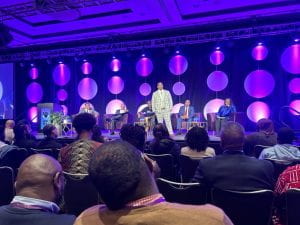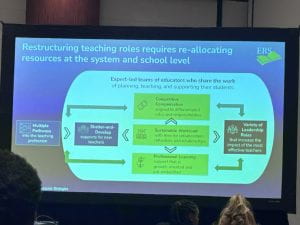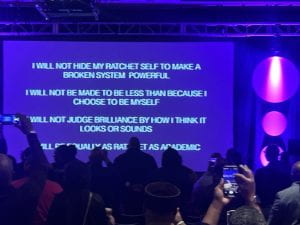I hate missing school. I get that guilty feeling that if I’m not there, things just wont go well. I had to get over that when I saw the pictures from #BMEC2022, I knew I wanted to attend the next one and I would miss as much school as necessary to be part of #BMEC2023, November 16-18, 2023. BMEC stands for Black Men in Education Convening. The images and sounds that brought me to in were the testemonials chronicaled by one of my favorite educators, Mr. Raymond Ankrum, of men discussing their connections, seeing their small groups and large sessions, hearing the music, and the overall visual of Black educators, mostly men, coming together focuse on how to support each other and our Black children. The convening is organized by members of the Center for Black Educator Development, and their CEO Mr. Sharif El Mekki.
Intro music with Kuf Knotz & Christine Elise
Kuf and Christine did an amazing job setting the tone during breakfast with their beats, lyrics, and harp. Every breakfast should have live music in the background! I sat with a team from the Baltimore Montessori Charter School (Assistant Principal and 6 teachers) and we had the opportunity to share our experiences as educators in our current roles. I shared that I spent time in BCPS and HCPS, so we shared some experiences. We compared the demographics and socio-economic communities that we serve, and one of the team asked me what my biggest challenge is and I said entitlement. I shared my most recent challenge of stadium construction and graduation, and they were floored. They couldn’t believe the opportunity that we have to rebuild a space and the community pushing back. It was grounding to hear how our situations contrast.
Libations with Dr. Greg Carr
Dr. Carr is one of my favorite educators. I have been watching him for over 3+ years every Saturday morning with Karen Hunter on In Class with Carr. He’s a genius. He knows so much about so much and participating in my first libation with him leading was on another level. Our acknowledgement of our ancestors, those who set the foundation for our current existence. Africans created education. The languages, the courses are African and we’re in a current system built on our creation.
Black Teacher Pipeline Part I: Dr. Watlington, Senator Vincent Hughes, Dr. Robert Simmons III, Naeem Jenkins-Nixon, Dr. Tequilla Brownie
Dr. Brownie started off talking about 50+% of our students being non-white, but our teaching population is so low because we are not tapping into the parents that created these students. I have had several interactions with Black families whose children have had multiple negative experiences in our school. From microagressions to out-right racist acts. How could I utilize those parents to help educate our community and support their children? Could I get a coalition of families together to share their experience with the greater community? Do I just want to help these students and families navigate this system or do we change it? Would it be more worthwhile to bring those parents together and create a space where we support our children, without other community members? Do I have a different role (or even a more important role) in the process as the Black administrator?
One of the biggest takeaways from the panel was Senator Hughes‘ emphasis on political action. Policy and funding matter. We must go on the offensive. We must assert ourselves to make the changes that our students need, to grow and sustain the pipeline through financial means. What does political action look like from the building principal desk? Is it getting a better understanding of LCFF & LCAP, or district budget, or our site budget? Is it getting active with ACSA and their political arm?
Empowering Educators through Affinity Conversations: Kim Lopez, Dr. Tawanda Bond, Khayree Bey, and Natika Hartstock
The panel, led by Ms. Lopez of Rodel, spoke about their role in bringing affinity spaces to their districts in Delaware. They felt the spaces helped them become a voice for their peers, students, and community. They were allowed to intentional create a common space. Mr. Bey mentioned the process his district went through “a journey” creating their “Educators of Color” space. They participated in Courageous Conversations which led to creating more “Brave spaces”. He felt that the process of growing the spaces has been productive, but it is crucial to have continuous movement. Don’t stop fighting. Dr. Bond addressed how affinity spaces are benefitting their districts. She jumped into the quantitive data that she had gathered about the experiences of staff members, not feeling supported, connected, valued, before they brought affinity spaces to her district. One of the first steps she took was a form of equity audit, what she called focus groups, to gather data from all staff. She asked questions to non-Black staff members like, “What does it feel like to be in a radicalized space?” She found that, “people are tired.” She asked the questions: How do we sustain? Are we preparing our replacements (the next generation of teachers)? Are we institutionalizing the process of affinity spaces for BIPOC and Non-BIPOC groups? In her district they’ve developed spaces for both groups, with two different sets of goals. Belonging, retention, and growth (BIPOC). Speaking your truth, understanding and seeing that there are other experiences, (I missed the third goal in my notes) (non-BIPOC). Dr. Bond shared 2019 research that describes 5 reasons that Black male educators leave the profession: antagonistic work environments, lack of support, being undervalued as educators, and having to pay a higher cost/lack of compensation. The panel talked about the extensive training (6-months) necessary to lead affinity spaces. If the leaders are not trained well, then there is a strong possibility that participants can be re-traumatized when discussing impactful topics. When trained well, facilitators can create a space for healing radicalized trauma. I really want to tap into Dr. Bond and Ms. Lopez, because laying the foundation for affinity spaces could be very impactful for my site and our district. The idea of an audit really speaks to me because it would allow us to hold up a mirror to ourselves and our practices on campus.
Tell Us How to Make Teaching the Job Everyone Wants: David Rosenberg, Dr. Nicole Hughes, and Chong-Hao Fu
This session was designed to be interactive, to allow us participants the opportunity to discuss how to improve the framework that the presenters designed (Picture #2). The presenters showed their Educator Resource Strategies support structure and asked, what is missing that educators would need to make the teaching job more desirable? When we shared out there were some great ideas: Safety, both Psychological and Physical. One leader shared that she feels “duplicitous” because she recruits Black educators, but does not want to recruit them into spaces that will cause them harm. I understand that feeling. Another participant mentioned that in his district, the majority of new hires have not gone through a teacher preparation program, yet they hire them and forget who they hire because they do not provide adequate support. Someone else brought up that it is easy to leave the profession when newcomers do not have relationships with peers or administrators. Besides the need to provide safety, the other big takeaway for me was the importance of have a strong adult culture. Having a staff that is connected to one another, is celebrated, and actually wants to work together, makes a difference.
Becoming an International Leader: Connecting Multicultural Education with Global Narratives: Abeer Ramadan-Shinnawi, Jad Evangelo-Nasser
I can’t say enough about the importance of intentionaly centering the stories of the Global Majority. The key to liberation is global education. There were so many Black ancestors and elders highlighted in this session that I just could not keep up with my notes and stay fully present. We need to teach Black history from a global lens, Africa, Haiti, Congo, Sudan, Palestine, as just a few examples.
Thank you to Jad and Abeer!
Fireside chat with Taye Diggs, Johnny McInnis, and Horace Ryans, w/Dr. Will Hayes
Taye Diggs had my favorite quote from this session. It was actually an echo from a previous discussion during the day. He encourged those in the room to encourage young people to, “Figure out what you love and do that.” Our kids, teachers, and staff are constantly questioning themselves, “Am I enough?” You are! We are!
Closing Keynote – Dr. Chris Emdin
So so powerful. Dr. Emdin is a hip-hop educator focused on the impact of curriculum. We (Black people) are a spiritual people. We allow our children to be taught by those who are focused on themselves and to not recognize their own or our spirituality. Why do we allow systems that are below us to be seen as the standard? Children see the spirit of those in front of them and respond, usually through disengagement, in kind. He used the metaphor of a peacock and a lion. The peacock expands its plume in response to a threat and can scare away a lion. Our children have been beat down and are often unable/too tired to continue to raise their feathers.
He railed on the concept of co-conspiritors in the work of freedom and asked the question: What is my vision for my legacy? My legacy = resist oppression. “Their” legacy = inflict oppression. Seeking abolition from slavery with the slaver seems like a contradiction. Conspiricy denotes negativity and it reinforces the current structure. As such, how do we show Black and Brown students the way to freedom: You be free. We have sacrificed our gives for the comfort of the system.
The Oreo – America’s favorite cookie. The white filling can’t hold up without the strength of the black cookie.
Healing Circle: Healing in a Time of Crisis: Abeer Ramadan-Shinnawi
I had originally planned to attend this session, but got caught in another. That other session just wasn’t doing if for me and I felt a pull toward the circle. I thought it was going to be a session where we talked about/learned circle strategies for students, but it ended up being a session for the practitioners. To respect the members of the circle I will not share their stories, but I will just say that it was very powerful to be in their presence and for them to share so openly. It meant a lot. I will say that I did get to meet Ms. Joyce Abbott, the 6th grade teacher that the sitcom Abbott Elementary was named for.
Leadership Journey by Big Picture Learning: Mike Africa, Shavar Jeffries, Sharif El-Mekki
I had never been in a space that was party/storytelling/community like this Leadership Journey session. It is something that you just have to experience. There is an MC, a hosts, a DJ, and 3 speakers. The speakers are asked questions, then are able to share an image and tell a story as answers. These three men were asked some very specific and challenging questions and I so appreciated their vulnerability and passion for not only life, but the impact that their life has on others.
I learned so much from this three day experience. I felt connected. I felt whole. I felt powerful. I felt and feel proud to be a Black Male Educator!


















